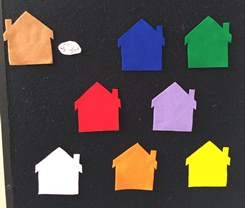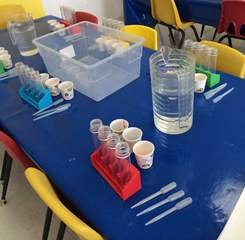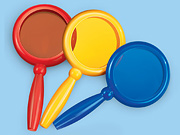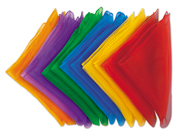Unlike a standard storytime, this one was limited to 18 children ages 3 to 5, and they were required to have an adult with them. It was also 45 minutes, rather than 30.
Opening Song: “I Am Here & You Are Here” by Peter & Ellen Allard (on Sing It! Say It! Stamp It! Sway It! Vol. 3)
 Story: Mouse Paint by Ellen Stoll Walsh. I knew that a lot of the kids would know this one already, so I just started by telling them that if they already knew it, they could help us all guess what would happen. Many of the kids knew which primaries mix to make the secondaries, although far fewer knew red+blue=purple than knew either green or orange, which I found interesting. At the end of the story, I told them that they’d all get the chance to mix colors themselves later on. If I hadn’t planned the color mixing activity in the test tubes, I probably would have read Mouse Paint twice and done a demonstration of the color mixing during the second reading.
Story: Mouse Paint by Ellen Stoll Walsh. I knew that a lot of the kids would know this one already, so I just started by telling them that if they already knew it, they could help us all guess what would happen. Many of the kids knew which primaries mix to make the secondaries, although far fewer knew red+blue=purple than knew either green or orange, which I found interesting. At the end of the story, I told them that they’d all get the chance to mix colors themselves later on. If I hadn’t planned the color mixing activity in the test tubes, I probably would have read Mouse Paint twice and done a demonstration of the color mixing during the second reading.
 Song: “Little Mouse” song w/felt board. There were only 16 kids, so I let everyone take a turn at guessing. If they got it right, they got to hide the mouse under a new house. The whole group was really into it for the first 10 guesses or so, but towards the end, only those who hadn’t had a turn yet were still really interested.
Song: “Little Mouse” song w/felt board. There were only 16 kids, so I let everyone take a turn at guessing. If they got it right, they got to hide the mouse under a new house. The whole group was really into it for the first 10 guesses or so, but towards the end, only those who hadn’t had a turn yet were still really interested.
The story and song took about 15 minutes. After “Little Mouse,” I introduced the activities and let the kids take them at their own pace. One entering kindergartener left about 5 minutes after we started open exploration time (his mother said he “doesn’t like crafts” and wasn’t really interested in the non-craft activities), but most stayed for 40-45 minutes. I’m told it felt organized from the patron’s side of things, but I spent all of the exploration time running around helping people, so I didn’t get many action shots. I hope the setup pictures give the general idea. Overall, this was a really fun program, although it was incredibly messy. Not the messiest I’ve ever done (curse you, cornstarch and water!), but close.

 Activity #1 (table): Color mixing. Put out pitchers of water; red, yellow, and blue liquid watercolors; droppers; and test tube stands. Let the kids experiment with mixing drops of watercolor into the clear water to make new colors. This was a big hit for most of the kids. It is amazing how putting something into a test tube makes it feel officially scientific. I put out an empty bucket in the middle of the table for kids to dump out their test tubes when they were done, plus pitchers of clean water for refills. I only had to refill the clean water pitcher once during the program. I put very little liquid watercolor in each cup in case of spills, and showed the adults where the extra was if they needed a refill. I didn’t see anyone actually refill the cups – it really only took a drop or two to dye the water.
Activity #1 (table): Color mixing. Put out pitchers of water; red, yellow, and blue liquid watercolors; droppers; and test tube stands. Let the kids experiment with mixing drops of watercolor into the clear water to make new colors. This was a big hit for most of the kids. It is amazing how putting something into a test tube makes it feel officially scientific. I put out an empty bucket in the middle of the table for kids to dump out their test tubes when they were done, plus pitchers of clean water for refills. I only had to refill the clean water pitcher once during the program. I put very little liquid watercolor in each cup in case of spills, and showed the adults where the extra was if they needed a refill. I didn’t see anyone actually refill the cups – it really only took a drop or two to dye the water.


Activity #2 (table): Filter paper painting. Put out giant filters and spray bottles of diluted liquid watercolor paint. The kids sprayed the filters and watched the colors run. I had considered having them then tie it up with a pipe cleaner to make a butterfly, but when I tried it, the creasing hid a lot of the colors, so I decided to leave it plain. This was fun, but definitely the messiest of the activities. I had to do a lot of wiping down afterwards – table, chairs, walls…. This one also led to the most questions about laundering! I had warned them to “dress for mess”, but the adults didn’t seem to think they were included in this warning. I had good luck washing it out of my clothes – I hope no one comes back later to tell me they did not. The kids really supersaturated their filters, so I had them each take an extra clean filter to put underneath when they laid them out to dry.

 Activity #3 (table): Gel paint swirls in a plastic bag using cornstarch & sugar gel paints. I ended up making two recipes for 18 kids. (I got the idea from The Hands-On Teacher.) I found this gel paint pretty easy to make, but there’s also one made out of hair gel that doesn’t require cooking. This isn’t really a color mixing experiment. The colors swirl, but they’re pretty hard to mix together. It is a great tactile activity – smooshing the gel around in the bag is totally addictive, and you can also draw pictures in it. I put white sheets of paper out on our table so that they would be able to see the bags better, but the setup was really just sandwich sized Ziploc bags and containers of gel paint. When I did this at home, I added some ultra fine glitter for added coolness. My kids also tried finger painting with it – it’s such a cool texture, it just begs to be played with! It was very pale on the paper, so it looked best when we drew a picture with crayon first and then painted over it with gel paint. I was worried about mold, so I stored the paints in the refrigerator before the program. I took them out about three hours before program time, but it wasn’t really enough – the paint was still cold and chunky. I was able to get the effect I wanted by holding the bag gently between my hands to warm up the gel, but the kids mostly smooshed their colors together. They seemed to have fun doing this, although it didn’t come out quite as nicely. The ideal, I guess, would be to make the gel paint right before you plan to use it. I’m not sure if I could have warmed it up some in the microwave? If I were to do this again, I’d take it out of the refrigerator much earlier.
Activity #3 (table): Gel paint swirls in a plastic bag using cornstarch & sugar gel paints. I ended up making two recipes for 18 kids. (I got the idea from The Hands-On Teacher.) I found this gel paint pretty easy to make, but there’s also one made out of hair gel that doesn’t require cooking. This isn’t really a color mixing experiment. The colors swirl, but they’re pretty hard to mix together. It is a great tactile activity – smooshing the gel around in the bag is totally addictive, and you can also draw pictures in it. I put white sheets of paper out on our table so that they would be able to see the bags better, but the setup was really just sandwich sized Ziploc bags and containers of gel paint. When I did this at home, I added some ultra fine glitter for added coolness. My kids also tried finger painting with it – it’s such a cool texture, it just begs to be played with! It was very pale on the paper, so it looked best when we drew a picture with crayon first and then painted over it with gel paint. I was worried about mold, so I stored the paints in the refrigerator before the program. I took them out about three hours before program time, but it wasn’t really enough – the paint was still cold and chunky. I was able to get the effect I wanted by holding the bag gently between my hands to warm up the gel, but the kids mostly smooshed their colors together. They seemed to have fun doing this, although it didn’t come out quite as nicely. The ideal, I guess, would be to make the gel paint right before you plan to use it. I’m not sure if I could have warmed it up some in the microwave? If I were to do this again, I’d take it out of the refrigerator much earlier.

 Activity #4 (rug): Put out a basket of colored scarves and let the kids look at them (and anything else) through the color viewers. This was most popular with the youngest three-year-olds and some younger siblings.
Activity #4 (rug): Put out a basket of colored scarves and let the kids look at them (and anything else) through the color viewers. This was most popular with the youngest three-year-olds and some younger siblings.
Other ideas I didn’t go with this time:
- Skittles (or m&m’s) in water
- Milk w/food coloring & soap
- Colored water & oil shaker bottles (or save that or the rheoscopic fluid bottle for Water Science Storytime?)
Little Mouse
To the tune of “Twinkle Twinkle”
Little mouse, little mouse,
Come out to play.
What color house
Are you in today?
Let the kids take turns guessing house colors. If they find the mouse, they can hide it.
Comments on: "Colors (Science Storytime)" (4)
[…] Colors (Science Storytime) […]
[…] Colors (Science Storytime) […]
[…] Colors (Science Storytime) […]
[…] Colors (Science Storytime) […]